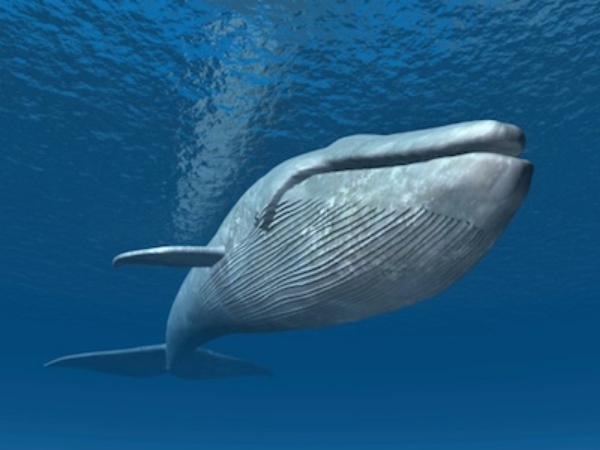Blue whales are the biggest animals ever, bigger than a dinosaur.
A blue whale calf is very big, almost as long as a bus.
Blue whales can dive very deep in the ocean.
They can hold their breath for a very long time.
In the water their skin looks blue, but it is pale grey.
The grooves underneath its mouth expand when the blue whale feeds © Getty Images
This means they have fringes of fibres called baleen in their mouths that act like strainers. When feeding, the whale gulps a vast mouthful of water.
Grooves under the whale's jaw expand to allow a bigger amount of water to be gulped, then they close, which squeezes the water out of the sides of the whale's mouth, and tiny sea creatures such as krill and plankton remain inside the mouth.
So, the largest animal on Earth feeds almost entirely on the smallest creatures in the sea, krill. At certain times of the year, blue whales consume almost 4 tonnes of tiny krill per day.
The largest animal also does the largest poop! It’s bright orange, the colour of krill, and it comes out in a long, thin stream near the surface of the ocean. It brings nutrients from the deepest part of the ocean and also to the the ocean floor when it sinks.
Read about blue whale poo!
The blue whale is the largest animal ever to inhabit the Earth!
At up to 30 metres long and 130 tonnes in weight, it is bigger than any of the dinosaurs were. Its tongue alone weighs as much as an elephant, its heart is as big as a car. Females are larger than males.
The largest of all animals: the blue whale ©Getty Images
Blue whale calls are the loudest of any animal. Its calls can be heard for hundreds of kilometres.
Blue whales are found in all the world's oceans
The whales are usually on their own but sometimes in pairs. They have grey-blue skin with light spots, but when seen underwater they look blue. Blue whales generally leave the icy polar areas in winter and migrate to warmer temperate to subtropical areas, where females give birth, and then return to the polar regions for spring and summer.
Blowholes on the top of a whale's head are how it exhales. Like all baleen whales, the blue whale has two blowholes close together. When you have held your breath for a while, you breathe out, or exhale. Whales exhale through their blowholes. The blow, or spout of air and steam that spurts from a blue whale's blowholes, can be nearly 9 metres high.
Life Cycle of the Blue Whale
Blue whales can breed from when they are about 7 - 10 years old. Females generally breed every 2 or 3 years. It is believed that blue whales breed in the deep waters of tropical oceans - Pacific, Atlantic and Indian Oceans. A female blue whale gives birth about a year after mating with a male blue whale.
When it is newborn, a blue whale calf is already one of the biggest animals on earth!
Newborn blue whales are 8 metres long and 2,700 to 3,600 kg in weight. Calves suckle on their mother's milk , which is very rich so that they gain weight and a layer of blubber quickly, ready for the return to icy polar waters. Calves gain about 90kg a day, and when they stop feeding from their mothers 7 months later, they are 18 metres long and weigh about 23 tonnes!
Blue whales can live for about 80 years.
Conservation Status and Threats
Blue whales lift their tails (flikes) when they dive. ©Getty Images
Blue whales are classified as Endangered, but there is not enough information about some populations to know their numbers. They were once considered too difficult to hunt because of their speed and tremendous size.
However, with the introduction of factory ships and the harpoon gun in the 1920s, blue whales were hunted intensively. By the 1960s they were nearly extinct. It is estimated that there are between 10,000 and 20,000 left.
Threats to the survival of blue whales are:
climate change
ocean pollution
illegal whaling




